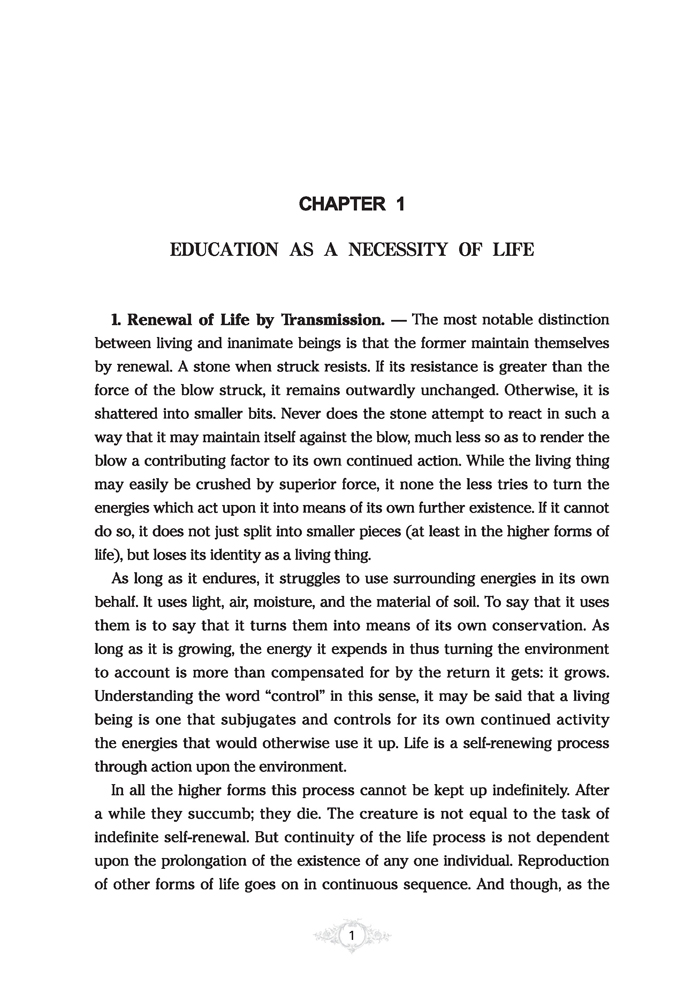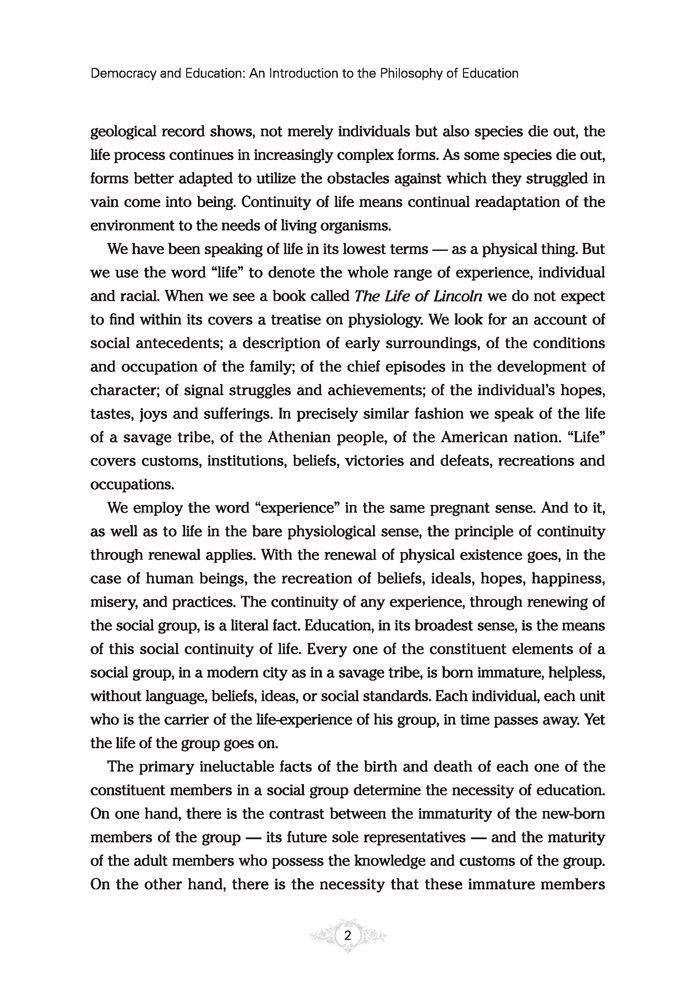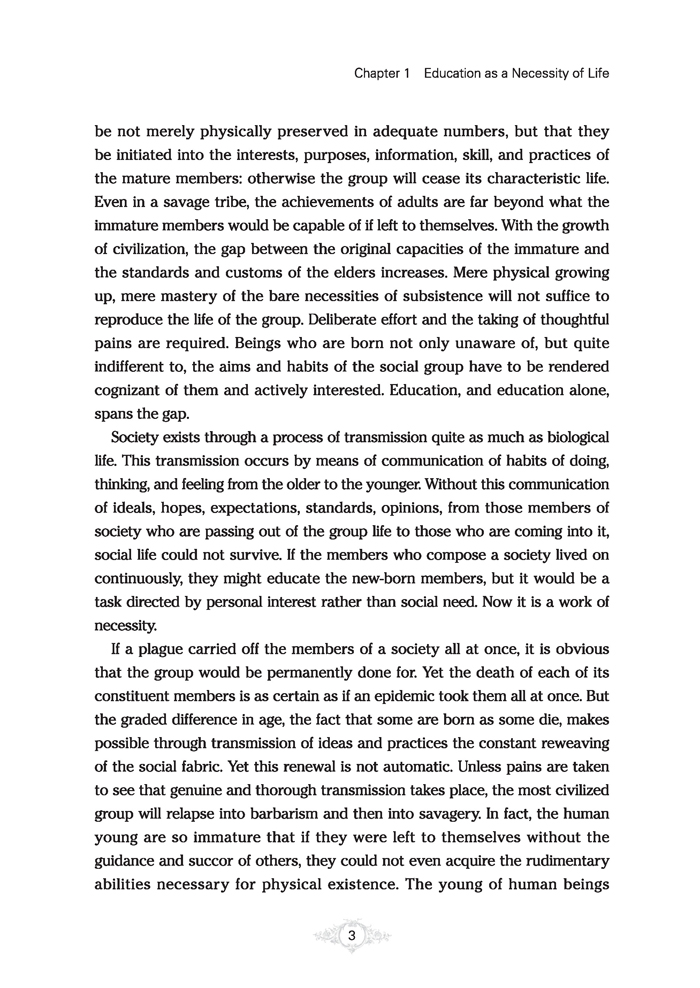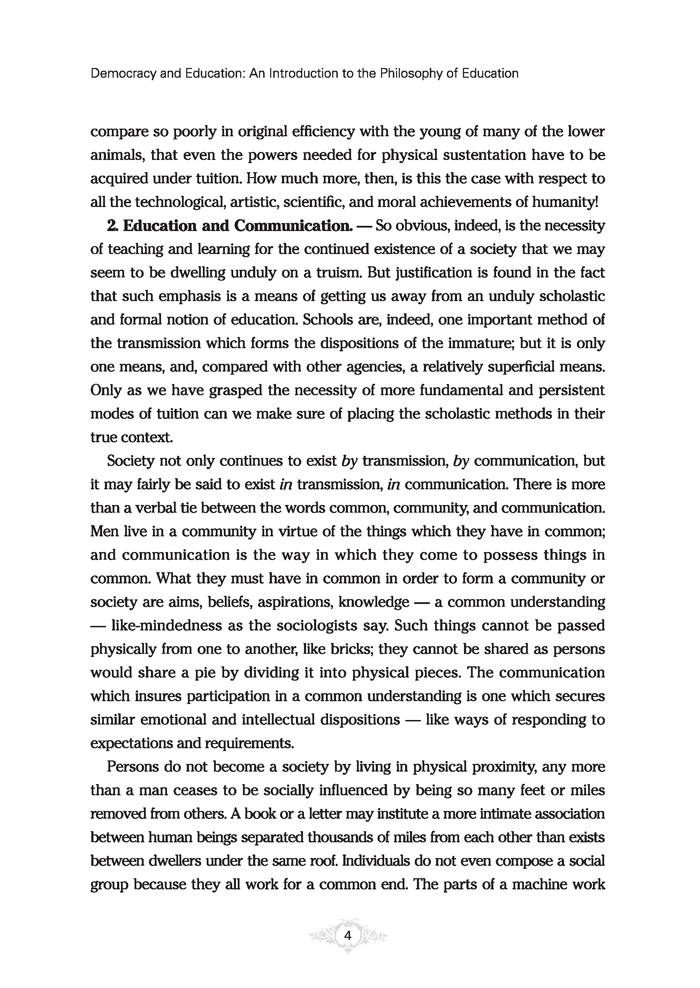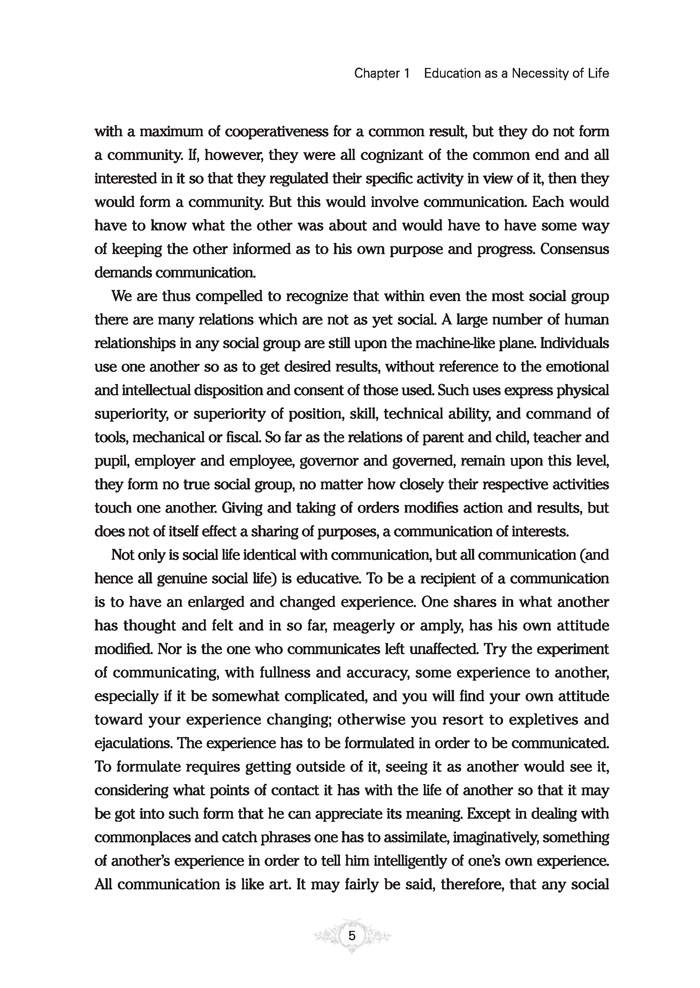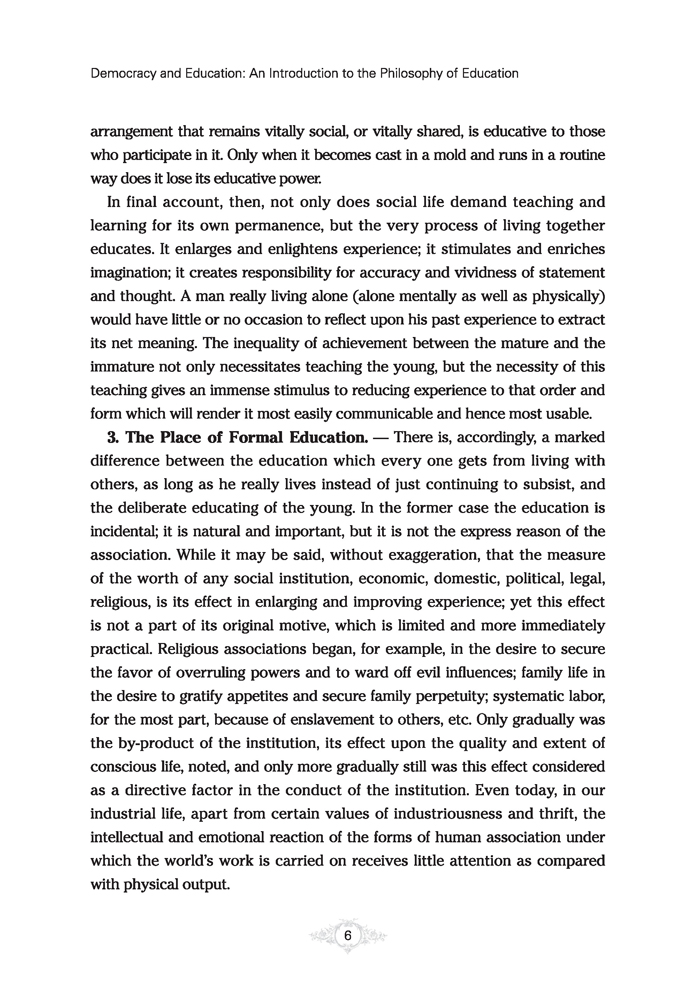 教育名著
教育名著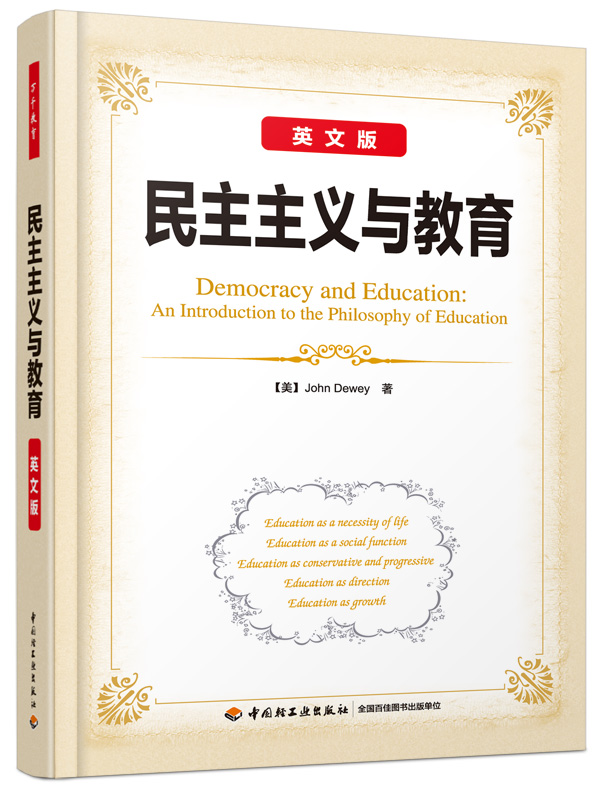
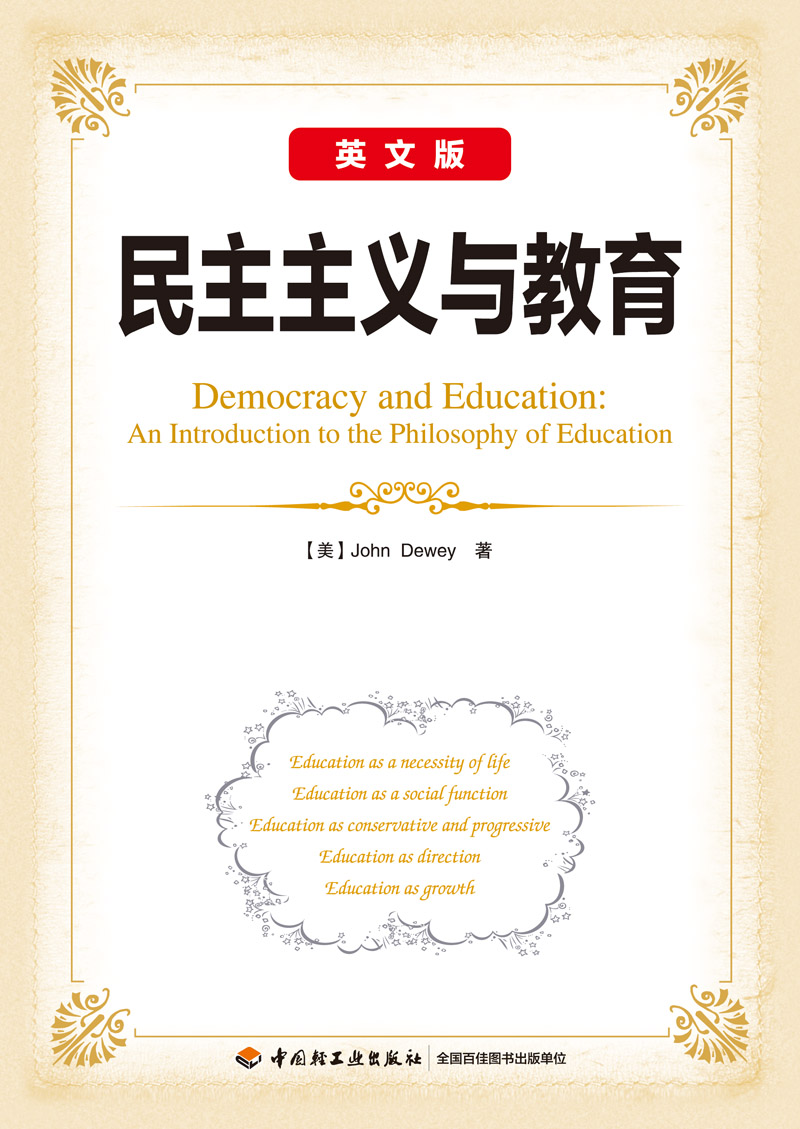


本书是美国实用主义哲学家、教育家和心理学家杜威的代表作《民主主义与教育》的英文版。
1981年,该书与拉尔夫·泰勒的《课程与教学的基本原理》一起被美国的《卡潘》(Phi Delta Kappan)杂志评为自1906年以来对学校课程领域影响最大的两本著作。西方学者称杜威的《民主主义与教育》、柏拉图的《理想国》和卢梭的《爱弥儿》是不朽的教育瑰宝。
为了使本书适应中国读者的阅读习惯,我们对英文原著的体例和个别单词的拼写进行了调整。2014年《民主主义与教育》的中文版已由我社出版,读者可根据自己的阅读需求选购。
1.《民主主义与教育》是杜威的代表作,是学习与研究教育学、心理学和哲学的人士必读的经典名著。为了满足读者阅读英文原著的需求,我们根据国内读者的阅读习惯,对英文原著的内容重新进行了精心的录入、编校和排版,出版了《民主主义与教育(英文版)》。该书还适合在高校有关专业的“名著选读”和“专业外语”课程中使用。
2.《民主主义与教育(英文版)》制作精美,很值得学习和收藏。
3.《民主主义与教育》的中文版已于2014年在中国轻工业出版社出版,读者可对照阅读使用。
约翰·杜威(JohnDewey,1859—1952),美国早期机能主义心理学的重要代表,美国最著名的实用主义哲学家、教育家和心理学家。
他出生在佛蒙特州,1879年毕业于佛蒙特大学,1884年在霍普金斯大学获得博士学位。1884—1888年,1890—1894年在美国密歇根大学,1889年在明尼苏达大学教授哲学。1894—1904年在芝加哥大学任哲学、心理学和教育学系主任,1902—1904年任该校教育学院院长。1904—1930年,任哥伦比亚大学哲学系教授。曾担任美国心理学联合会、美国哲学协会、美国大学教授联合会主席。1896—1903年创办了芝加哥大学实验学校作为其教育理论的实验基地,并任该校校长。
杜威的主要著作有《我的教育信条》(1897)、《学校与社会》(1899)、《儿童和课程》(1902)、《教育上的道德原理》(1909)、《教育上的兴趣和努力》(1913)、《民主主义与教育》(1916)、《哲学的改造》(1920)、《经验与自然》(1925)、《确定性的寻求》(1929)、《教育科学的资源》(1929)、《旧个人主义与新个人主义》(1930)、《我们怎样思维》(修订本,1933)、《教育与经验》(1938)、《自由与文化》(1939)、《价值的学说》(1939)、《人的问题》(1946)等。
PREFACE
The following pages embody an endeavor to detect and state the ideas implied in a democratic society and to apply these ideas to the problems of the enterprise of education. The discussion includes an indication of the constructive aims and methods of public education as seen from this point of view, and a critical estimate of the theories of knowing and moral development which were formulated in earlier social conditions, but which still operate, in societies nominally democratic, to hamper the adequate realization of the democratic ideal. As will appear from the book itself, the philosophy stated in this book connects the growth of democracy with the development of the experimental method in the sciences, evolutionary ideas in the biological sciences, and the industrial reorganization, and is concerned to point out the changes in subject matter and method of education indicated by these developments.
Hearty acknowledgments are due to Dr. Goodsell of Teachers College for criticisms; to Professor Kilpatrick of the same institution for criticisms, and for suggestions regarding the order of topics, of which I have freely availed myself, and to Miss Elsie Ripley Clapp for many criticisms and suggestions. The two firstnamed have also been kind enough to read the proofsheets. I am also greatly indebted to a long line of students whose successive classes span more years than I care to enumerate.
John Dewey
Columbia University, New York City
August, 1915
CHAPTER 1
EDUCATION AS A NECESSITY OF LIFE
1. Renewal of Life by Transmission. — The most notable distinction between living and inanimate beings is that the former maintain themselves by renewal. A stone when struck resists. If its resistance is greater than the force of the blow struck, it remains outwardly unchanged. Otherwise, it is shattered into smaller bits. Never does the stone attempt to react in such a way that it may maintain itself against the blow, much less so as to render the blow a contributing factor to its own continued action. While the living thing may easily be crushed by superior force, it none the less tries to turn the energies which act upon it into means of its own further existence. If it cannot do so, it does not just split into smaller pieces (at least in the higher forms of life), but loses its identity as a living thing.
As long as it endures, it struggles to use surrounding energies in its own behalf. It uses light, air, moisture, and the material of soil. To say that it uses them is to say that it turns them into means of its own conservation. As long as it is growing, the energy it expends in thus turning the environment to account is more than compensated for by the return it gets: it grows. Understanding the word “control” in this sense, it may be said that a living being is one that subjugates and controls for its own continued activity the energies that would otherwise use it up. Life is a self-renewing process through action upon the environment.
In all the higher forms this process cannot be kept up indefinitely. After a while they succumb; they die. The creature is not equal to the task of indefinite self-renewal. But continuity of the life process is not dependent upon the prolongation of the existence of any one individual. Reproduction of other forms of life goes on in continuous sequence. And though, as the geological record shows, not merely individuals but also species die out, the life process continues in increasingly complex forms. As some species die out, forms better adapted to utilize the obstacles against which they struggled in vain come into being. Continuity of life means continual readaptation of the environment to the needs of living organisms.
We have been speaking of life in its lowest terms — as a physical thing. But we use the word “life” to denote the whole range of experience, individual and racial. When we see a book called The Life of Lincoln we do not expect to find within its covers a treatise on physiology. We look for an account of social antecedents; a description of early surroundings, of the conditions and occupation of the family; of the chief episodes in the development of character; of signal struggles and achievements; of the individual’s hopes, tastes, joys and sufferings. In precisely similar fashion we speak of the life of a savage tribe, of the Athenian people, of the American nation. “Life” covers customs, institutions, beliefs, victories and defeats, recreations and occupations.
We employ the word “experience” in the same pregnant sense. And to it, as well as to life in the bare physiological sense, the principle of continuity through renewal applies. With the renewal of physical existence goes, in the case of human beings, the recreation of beliefs, ideals, hopes, happiness, misery, and practices. The continuity of any experience, through renewing of the social group, is a literal fact. Education, in its broadest sense, is the means of this social continuity of life. Every one of the constituent elements of a social group, in a modern city as in a savage tribe, is born immature, helpless, without language, beliefs, ideas, or social standards. Each individual, each unit who is the carrier of the life-experience of his group, in time passes away. Yet the life of the group goes on.
The primary ineluctable facts of the birth and death of each one of the constituent members in a social group determine the necessity of education. On one hand, there is the contrast between the immaturity of the new-born members of the group — its future sole representatives — and the maturity of the adult members who possess the knowledge and customs of the group. On the other hand, there is the necessity that these immature members be not merely physically preserved in adequate numbers, but that they be initiated into the interests, purposes, information, skill, and practices of the mature members: otherwise the group will cease its characteristic life. Even in a savage tribe, the achievements of adults are far beyond what the immature members would be capable of if left to themselves. With the growth of civilization, the gap between the original capacities of the immature and the standards and customs of the elders increases. Mere physical growing up, mere mastery of the bare necessities of subsistence will not suffice to reproduce the life of the group. Deliberate effort and the taking of thoughtful pains are required. Beings who are born not only unaware of, but quite indifferent to, the aims and habits of the social group have to be rendered cognizant of them and actively interested. Education, and education alone, spans the gap.
Society exists through a process of transmission quite as much as biological life. This transmission occurs by means of communication of habits of doing, thinking, and feeling from the older to the younger. Without this communication of ideals, hopes, expectations, standards, opinions, from those members of society who are passing out of the group life to those who are coming into it, social life could not survive. If the members who compose a society lived on continuously, they might educate the new-born members, but it would be a task directed by personal interest rather than social need. Now it is a work of necessity.
If a plague carried off the members of a society all at once, it is obvious that the group would be permanently done for. Yet the death of each of its constituent members is as certain as if an epidemic took them all at once. But the graded difference in age, the fact that some are born as some die, makes possible through transmission of ideas and practices the constant reweaving of the social fabric. Yet this renewal is not automatic. Unless pains are taken to see that genuine and thorough transmission takes place, the most civilized group will relapse into barbarism and then into savagery. In fact, the human young are so immature that if they were left to themselves without the guidance and succor of others, they could not even acquire the rudimentary abilities necessary for physical existence. The young of human beings compare so poorly in original efficiency with the young of many of the lower animals, that even the powers needed for physical sustentation have to be acquired under tuition. How much more, then, is this the case with respect to all the technological, artistic, scientific, and moral achievements of humanity!
2. Education and Communication. — So obvious, indeed, is the necessity of teaching and learning for the continued existence of a society that we may seem to be dwelling unduly on a truism. But justification is found in the fact that such emphasis is a means of getting us away from an unduly scholastic and formal notion of education. Schools are, indeed, one important method of the transmission which forms the dispositions of the immature; but it is only one means, and, compared with other agencies, a relatively superficial means. Only as we have grasped the necessity of more fundamental and persistent modes of tuition can we make sure of placing the scholastic methods in their true context.
Society not only continues to exist by transmission, by communication, but it may fairly be said to exist in transmission, in communication. There is more than a verbal tie between the words common, community, and communication. Men live in a community in virtue of the things which they have in common; and communication is the way in which they come to possess things in common. What they must have in common in order to form a community or society are aims, beliefs, aspirations, knowledge — a common understanding — like-mindedness as the sociologists say. Such things cannot be passed physically from one to another, like bricks; they cannot be shared as persons would share a pie by dividing it into physical pieces. The communication which insures participation in a common understanding is one which secures similar emotional and intellectual dispositions — like ways of responding to expectations and requirements.
Persons do not become a society by living in physical proximity, any more than a man ceases to be socially influenced by being so many feet or miles removed from others. A book or a letter may institute a more intimate association between human beings separated thousands of miles from each other than exists between dwellers under the same roof. Individuals do not even compose a social group because they all work for a common end. The parts of a machine work with a maximum of cooperativeness for a common result, but they do not form a community. If, however, they were all cognizant of the common end and all interested in it so that they regulated their specific activity in view of it, then they would form a community. But this would involve communication. Each would have to know what the other was about and would have to have some way of keeping the other informed as to his own purpose and progress. Consensus demands communication.
